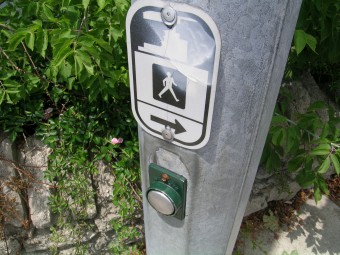Saturday, June 7, 2014
Many Crosswalk Signal Buttons Don’t Do Anything Anymore
Do you like this story?

Today I found out many crosswalk signal buttons actually don’t do anything when you press them. They are only there to give you something to press, called “placebo buttons”.
In New York City, for instance, an estimated 90% of these pedestrian crossing buttons do nothing. You’ll find the same trend in most major cities, particularly in the United States. The reason why is that allowing people to manually override set traffic timers can severely disrupt traffic. Instead, modern computerized systems are used to help maximize throughput in intersections, including factoring in pedestrian crossings automatically.
As the director of engineering at the Boston Transportation Department, John DeBenedictis states, “It’s a numbers game. We know that there are going to be pedestrians at virtually every single cycle during the day (at certain intersections).” So the buttons are disabled to let the system dictate the most efficient way to time things in the intersection.
In some cases, certain buttons actually do something specific times of the day, while other times they are ignored by the traffic system, generally during peak traffic times.
Some cities also program it so that the buttons won’t actually affect the timing of things, but only whether the “Walk” signal will display. “If you stand here and wait and don’t push it, you’ll never get that walk signal and legally, you’re not supposed to walk into the intersection without that walk signal. It’s a ticket-able offense,” states signal operations engineer Val Melvin in Spokane, Washington where this type of system is used widely.
Canada seems to be one of the few holdouts for keeping the crosswalk buttons working. As recent as 2008, most cities in Canada do not have placebo crosswalk buttons. In fact, in Victoria, British Columbia (population 80,000 city and 350,000 metro), it was found there weren’t any buttons that didn’t do something when you pressed them.
There is almost never any direct indication given as to which buttons do something and which don’t. As a general rule, though, the larger the city and the heavier the traffic in a particular intersection at a certain time of day, the less likely it is that the crosswalk buttons at that intersection actually do anything.
It should also be noted that even when the buttons are enabled and set to affect the timing of a light change, pressing them multiple times isn’t going to make the light change faster, nor will pressing an elevator button multiple times. Of course, people seem to like to do it anyways, which is perhaps why placebo crosswalk buttons are there. People like something to do while they stand and wait and there’s something inherently satisfying about pressing buttons.
Bonus Facts:
- According to research done on the roads of New Zealand, the common zebra striped crosswalk, without any additional signaling, actually increases the chances of pedestrians getting hit by a car by 28% over if the person had just Jaywalked. It is thought this is the case because pedestrians crossing in crosswalks are much less careful than those crossing the road elsewhere, even to the point that many people observed in studies don’t even bother to look if anyone is coming before entering a crosswalk. A similar study done in the United States on 1000 marked and unmarked popular crossing areas showed that marked locations had a much higher rate of pedestrian accidents than unmarked so long as there weren’t any other signals included with the crosswalk, such as a stop sign/light or flashing lights. They also found that including a raised “safety” median for pedestrians to stand in the middle of roads made no difference to the safety of the pedestrians regardless of the number of lanes on the road, so is essentially a waste of money to include in crosswalks.
- The first ever pedestrian crossing signal was put up in Westminster, London in 1868 by a railway engineer, John Peak Knight. You can read more about this and the development of traffic signals here.
- Rather than using buttons, even when they do something, some cities are now starting to use systems to automatically detect if people are standing at a crosswalk, similar to systems used for cars. In pedestrian systems, though, they typically rely on infrared, microwave, or weight sensors, whereas most car systems rely on inductance, though some use weight sensors.
Subscribe to:
Post Comments (Atom)


0 Responses to “Many Crosswalk Signal Buttons Don’t Do Anything Anymore”
Post a Comment